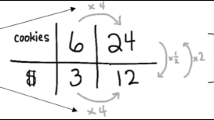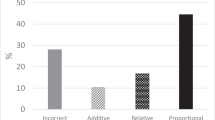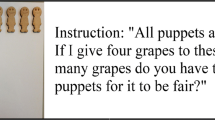Abstract
In this study, we investigate sixth, seventh, and eighth grade students’ achievement in nonlinear (quadratic or cubic) proportional problems regarding length, area, and volume of enlarged figures. In addition, we examine students’ solution strategies for the problems and obstacles that prevent students from answering the problems correctly by using a mixed method research design. A total of 935 middle school students were given a paper-pencil test and 12 of them were interviewed. Findings indicated that achievement of the participants were low and that students used a limited number of strategies for solving the problems. In addition, these strategies were found to have lacked the argument of the linear proportional and nonlinear proportional relationships among length, area, and volume concepts for most of the participants’ answers. Moreover, analysis revealed that the confusion of linear proportional and nonlinear proportional relationships and misinterpretation of additive and multiplicative relationships were serious obstacles while solving the nonlinear proportional problems related to the area and volume of enlarged figures.






Similar content being viewed by others
References
Behr, M., Harel, G., Post, T. & Lesh, R. (1992). Rational number, ratio and proportion. In D. Grouws (Ed.), Handbook on research of teaching and learning (pp. 296–333). New York, NY: McMillan.
Boyer, T. W., Levine, S. C. & Huttenlocher, J. (2008). Development of proportional reasoning: Where young children go wrong. Developmental Psychology, 44(5), 1478–1490.
Brousseau, G. (2002). Theory of didactical situations in mathematics. New York, NY: Kluwer Academic Publishers.
Common Core State Standards Initiative (2010). Common core state standards for mathematics. Retrieved from http://www.corestandards.org/Math/.
Cramer, K. & Post, T. (1993). Making connections: A case for proportionality. Arithmetic Teacher, 60(6), 342–346.
De Bock, D., Verschaffel, L. & Janssens, D. (1998). The predominance of the linear model in secondary school students’ solutions of word problems involving length and area of similar plane figures. Educational Studies in Mathematics, 35(1), 65–83.
De Bock, D., Verschaffel, L. & Janssens, D. (2002a). The effects of different problem presentations and formulations on the illusion of linearity in secondary school students. Mathematical Thinking and Learning, 4(1), 65–89.
De Bock, D., Van Dooren, W., Janssens, D. & Verschaffel, L. (2002b). Improper use of linear reasoning: An in-depth study of the nature and the irresistibility of secondary school students’ errors. Educational Studies in Mathematics, 50(3), 311–334.
Dey, I. (1993). Qualitative data analysis: A user-friendly guide for social scientists. New York, NY: Routledge.
Fernandez, C., Llinares S., Van Dooren, W., De Bock, D., & Verschaffel, L. (2010). The development of students’ use of additive and proportional methods along primary and secondary school. Retrieved from https://lirias.kuleuven.be/bitstream/123456789/407111/1/10HRP32.pdf.
Fraenkel, J. & Wallen, N. (2006). How to design and evaluate research in education. New York, NY: McGraw-Hill.
Gill, P. N. G. (1993). Non-linear proportionality in science problems. International Journal of Mathematical Education in Science and Technology, 24(3), 365–371.
Ginsburg, H. P. (1997). Entering the child’s mind: The clinical interview in psychological research and practice. New York, NY: Cambridge University Press.
Goldin, G. (1997). Observing mathematical problem solving through task-based interviews. Journal for Research in Mathematics Education. Monograph, 9, 40–177. doi:10.2307/749946.
Goldin, G. A. (2000). A scientific perspective on structured, task-based interviews in mathematics education research. In A. E. Kelly & R. A. Lesh (Eds.), Handbook of research design in mathematics and science education (pp. 517–546). Mahwah, NJ: Erlbaum.
Harel, G., Behr, M., Lesh, R. & Post, T. (1994). Invariance of ratio: The case of children’s anticipatory scheme for constancy of taste. Journal for Research in Mathematics Education, 25(4), 324–345.
Hart, K. M. (1981). Children’s understanding of mathematics (pp. 11–16). London, United Kingdom: John Murray Ltd.
Hunting, R. P. (1997). Clinical interview methods in mathematics education research and practice. The Journal of Mathematical Behavior, 16(2), 145–165.
Karplus, R., Pulos, S. & Stage, E. K. (1983). Early adolescents’ proportional reasoning on “rate” problems. Educational Studies in Mathematics, 14(3), 219–233.
Kvale, S. (2007). Doing interviews. Thousand Oaks, CA: Sage.
Lesh, R., Post, T. & Behr, M. (1988). Proportional reasoning. In J. Hiebert & M. Behr (Eds.), Number concepts and operations in the middle grades (pp. 93–118). Reston, VA: Lawrence Erlbaum & National Council of Teachers of Mathematics.
Lobato, J. & Thanheiser, E. (2002). Developing understanding of ratio as measure as a foundation for slope. In B. Litwiller (Ed.), Making sense of fractions, ratios, and proportions: 2002 yearbook (pp. 162–175). Reston, VA: National Council of Teachers of Mathematics.
Ministry of National Education [MoNE]. (2013). Ortaokul matematik dersi (5, 6, 7 ve 8. Sınıflar) öğretim programı [Middle school mathematics curricula for grades 5, 6, 7, and 8]. Ankara, Turkey: MEB.
Misailadou, C. & Williams, J. (2003). Measuring children’s proportional reasoning, the “tendency” for an additive strategy and the effect of models. In Proceeding of 27th International Group for the Psychology of Mathematics Education (Vol. 3, pp. 293–300). Retrieved from http://files.eric.ed.gov/fulltext/ED501129.pdf.
Modestou, M. & Gagatsis, A. (2007). Students’ improper proportional reasoning: A result of the epistemological obstacle of “linearity”. Educational Psychology, 27(1), 75–92.
Modestou, M. & Gagatsis, A. (2013). A didactical situation for the enhancement of meta-analogical awareness. The Journal of Mathematical Behavior, 32(2), 160–172.
Modestou, M. Elia, I., Gagatsis, A. & Spanoudes, G. (2007). Problem solving in geometry: The case of the illusion of proportionality. In D. Pitta-Pantazi & G. Philippou (Eds), Proceeding of 5th Congress of the European Society for Research in Mathematics Education (pp.1052–1062). Larnaca, Cyprus: European Society for Research in Mathematics Education.
National Council of Teachers of Mathematics (1989). Curriculum and evaluation standards for school mathematics. Reston, VA: The Council.
Resnick, L. & Singer, J. (1993). Protoquantitative origins of ratio reasoning. In T. Carpenter, E. Fennema & T. Romberg (Eds.), Rational numbers: An integration of research (pp. 107–130). Hillsdale, NJ: Lawrence Erlbaum Associates.
Tourniare, F. & Pulos, S. (1985). Proportional reasoning: A review of the literature. Educational Studies in Mathematics, 16, 181–204.
Van de Walle, J. A., Karp, K. S. & Bay-Williams, J. M. (2013). Elementary and middle school mathematics: Teaching developmentally (8th ed.). Boston, MA: Pearson Education, Inc.
Van Dooren, W., De Bock, D., De Bolle, E., Janssens, D. & Verschaffel, L. (2003a). Secondary school students’ illusion of linearity: The role of direct versus indirect perimeter and area measures. Mediterranean Journal for Research in Mathematics Education, 2, 1–18.
Van Dooren, W., De Bock, D., Verschaffel, L. & Janssens, D. (2003b). Improper applications of proportional reasoning. Mathematics Teaching in the Middle School, 9(4), 204–209.
Van Dooren, W., De Bock, D., Janssens, D. & Verschaffel, L. (2008). The linear imperative: An inventory and conceptual analysis of students’ overuse of linearity. Journal for Research in Mathematics Education, 39(3), 311–342.
Van Dooren, W., De Bock, D. & Verschaffel, L. (2010). From addition to multiplication…and back: The development of students’ additive and multiplicative reasoning skills. Cognition and Instruction, 28, 360–381.
Verschaffel, L., Greer, B. & De Corte, E. (2000). Making sense of word problems. Lisse, The Netherlands: Swets and Zeitlinger.
Author information
Authors and Affiliations
Corresponding author
Rights and permissions
About this article
Cite this article
Ayan, R., Isiksal Bostan, M. Middle School Students’ Reasoning in Nonlinear Proportional Problems in Geometry. Int J of Sci and Math Educ 16, 503–518 (2018). https://doi.org/10.1007/s10763-016-9777-z
Received:
Accepted:
Published:
Issue Date:
DOI: https://doi.org/10.1007/s10763-016-9777-z




